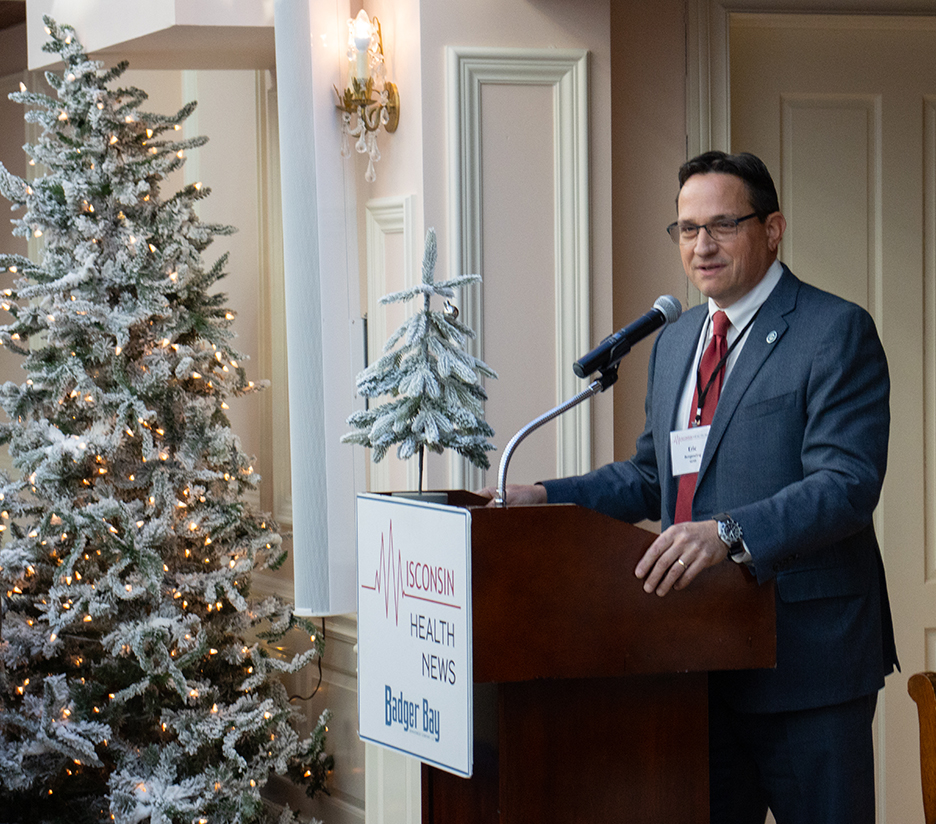Wisconsin Health News (WHN) held a panel moderated by WHN Editor Tim Stumm on Dec. 12 of Imran Andrabi, MD, CEO of ThedaCare; Gabrielle Finley-Hazle, president of Aurora Health Care; Daniel Jackson, CEO of Ascension Wisconsin; Alan Kaplan, MD, CEO of UW Health; and Eilidh Pederson, CEO of Western Wisconsin Health in Baldwin. Panelists discussed the ever-evolving health care landscape in Wisconsin.

WHA President and CEO Eric Borgerding introduced the panel.
WHA President and CEO Eric Borgerding introduced the panel and applauded the work of Wisconsin’s hospitals and their leaders.
“Today’s panel comes during what are the most challenging times I have seen in health care,” said Borgerding. “Workforce shortages persist, driven in part by Wisconsin’s demographic trends we can’t legislate, the inability to discharge patients to nursing homes continues to be as challenging as some of the most difficult times in COVID, and continuing pressure on reimbursement and the moving goalposts of regulation and red tape make delivering and being reimbursed for delivering care more difficult and complicated than ever.”
“Despite all of the challenges, Wisconsin hospitals continue to be some of the best performing in the country,” said Borgerding. “The most recent example is CMS ranking Wisconsin hospitals the fourth best for quality in the country. That is testimony to a lot of things, including the tremendous leaders we have in the state.”
Stumm started the panel asking about the biggest challenges facing hospitals and health systems. Workforce shortages, inflation and the costs of regulatory and payment complexity were all repeated themes from the hospital leaders on the panel.
 L to R: Tim Stumm; Alan Kaplan, MD; Gabrielle Finley-Hazle, Daniel Jackson, Eilidh Pederson, Imran Andrabi, MD.
L to R: Tim Stumm; Alan Kaplan, MD; Gabrielle Finley-Hazle, Daniel Jackson, Eilidh Pederson, Imran Andrabi, MD.
Pederson talked about the impacts of regulatory complexity and competing priorities on her hospital’s workforce and community.
“An additional challenge facing rural hospitals is competing priorities. Which regulation are we following today? Our staff have whiplash from which direction are they going to go and what truly are the best outcomes,” said Pederson. “The work that we can do to simplify their efforts and get back to basics is really crucial.”
Dr. Kaplan echoed the impacts of regulatory burden from government and payors on workforce and the cost of health care. He highlighted the growth of what he calls the “administrative waste industry” to manage ever more complex coding issues to receive payment and regulatory burden.
“It's estimated that 30% of the cost in health care is due to administrative waste,” said Kaplan. “The reason why you have such high growth over the decades in administrative personnel versus direct care personnel is because of regulatory burden. There are so many things in the regulatory environment that create what I call the waste industry.”
Dr. Kaplan highlighted prior authorization practices as an important driver of the waste industry.
“If you complicate coding, then I need to find specialized coders,” said Kaplan. “So there's new jobs that don't directly affect patient care but I need those people [to get paid for the services provided]. Then I need software and people to support that software. Then I need servers and data storage, but then there is another industry that arises—the consultants and software industry.”
“So every time a regulation or a law is passed, there is increased burden on cost on the inside of the hospital infrastructure which leads indirectly or directly to higher cost for commercial payers,” Kaplan said. He further noted that when new compliance burdens are added by government to health care, they amount to unfunded mandates not reflected in Medicare or Medicaid payments. “Why? Because the government isn’t going to pay more [for those regulations].”
Dr. Andrabi also connected workforce burnout with regulatory and administrative burdens and the significant capital investments being made by hospitals and health systems in technology to mitigate those burdens.
“We need to think about how to help partners really get to the top of their license and take some of the day-to-day maybe mundane things off their plate that can be automatized for them,” said Dr. Andrabi.
He discussed investments in artificial intelligence that could automate processes like chart review. “Chart reviews…are a very labor-intensive process and usually we’ll end up using nurses as quality specialists to go into a chart and do first level review. That would be something that AI can do for your first level of review and present it to somebody who’s actually looking at the clinical data.”
Dr. Kaplan also discussed the investments UW Health is making in artificial intelligence to reduce the burden on physicians for unreimbursed tasks.
He referenced said that doctors are often “up late at night answering patients’ [inbox questions] and in most plans it’s not reimbursable and it puts a lot of strain and drain and burnout on our physicians.” Dr. Kaplan said that they are working with Microsoft and Epic to utilize artificial intelligence to read patient inbox questions and prepare a proposed response for the physician, saving significant time for the physician.
Pedersen echoed the benefits of technology to address such workforce burdens but also the cost strains on rural hospitals of those capital investments.
“We do have some access to AI things like that that will help with predictive text for physicians, and I see that allowing physicians to focus on quality and the patient experience as opposed to checking boxes feeding the beast that is the electronic medical record,” said Pederson. “This is a tremendous benefit to our patients and to our community. Through our partnership with Alina Hospital, we have access to Epic, but most small hospitals do not have access to Epic.”
Dr. Andrabi also highlighted increasing capital costs for such investments coming at the same time as inflationary labor costs and skyrocketing pharmaceutical expenses that are hitting hospital operational costs.
“When we talk about automation and technology that costs a lot of money,” said Dr. Andrabi, “If you want to do any kind of capital project, the costs have doubled and tripled, if you can find it.”
While also facing “therapeutic costs for drugs and pharmaceuticals going through the roof,” Andrabi said that ThedaCare made over $100 million in investments in its labor force in the past two years. “That’s not easy to come up with when you are dealing with a whole host of other things. But it was the right thing to do…to invest in your folks and be competitive in the market.”
Stumm noted the rise of nursing union strikes across the country and asked Dr. Kaplan about the status of SEIU’s effort to unionize nurses at UW Health.
“Yes, there is a move to organize at UW Health and it began basically this time in 2019,” said Dr. Kaplan. “We care about all our nurses and we have very strong shared governance practice.”
“We recognize that any nurse has a right to affiliate and we have nurses that have chosen to affiliate with SEIU,” said Dr. Kaplan.
“It’s a tricky situation because only about 18% of our nurses are union paying dues members and the rest are not,” said Dr. Kaplan. “So when we meet with the nurses that have union interests, they represent a small minority of our nurses.”
Additional information regarding a DHS report stating that patient safety complaints SEIU nurses brought against UW Hospital were not substantiated can be found at "
DHS and CMS Substantiate High Quality Care and Culture of Safety" in today’s WHA Newsletter.
Despite these challenges, the panelists discussed hospitals’ continued focus on cost and quality.
“Health care has spent a lot of time and effort on building that structure and infrastructure and the data definitely shows that not only is it lowering cost but it's also producing better outcomes for the community,” said Gabrielle Finley-Hazle, president of Aurora Health Care.
Finley-Hazle shared data provided to CMS quantifying the cost savings to the Medicare program due to Advocate’s efforts in the Medicare savings plan.
“It was just reported by CMS that we saved $120 million [in Medicare costs], the largest of any other integrated health system in the county,” said Finley-Hazle.
But she also talked about the personal impacts throughout Wisconsin of hospitals’ commitment to their communities.
“I reflect back as I’m going through the care sites across the State of Wisconsin. I think about the services we provide at our Walker’s Point clinic in southside Milwaukee, providing free care services for 13,000 visits, or going out to a clinic in northwest Wisconsin where families are hugging providers for care that is being provided,” said Finely-Hazle. “There is a heaviness of what we have to deal with, but it’s inspiring to see the work that’s being done every day by all of these health care systems caring for the community in Wisconsin.”
Pederson talked about her hospital in Baldwin stepping up to fill a community need for obstetrical services and the challenge of sustainably providing those services.
“In our 60-mile radius over the last three years, four hospitals have stopped delivering babies,” said Pederson. “We know that this is not unique to our area. More than 50% of rural hospitals no longer provide obstetrical care. We have made it our quest to be there when others can't to step up and find a way to make it work. But, you know this is not sustainable. We need some real reimbursement reform in the obstetrical space to make the difference here on this very human issue.”
That same focus on mission and community needs while also managing cost and reimbursement challenges equally applies in urban settings.
Jackson emphasized the critical safety net role Ascension’s Milwaukee hospitals embrace in Milwaukee.
“The things we’ve done cater to the community that we serve in alignment with our mission have been the focus,” said Jackson. “We have operated, particularly in Milwaukee, as a safety-net facility. That creates its own set of challenges. But those are challenges that we embrace because they align with our mission.”
“As we evolve across our footprint of Wisconsin, we take those things into account, being very specific and mindful of the services that we provide in the community that aligns with the need of the community,” said Jackson.
Finley-Hazle also talked about meeting community needs and collaborations to meet those needs, such as the new Milwaukee Mental Health Emergency Center. But she also noted that hospitals cannot do everything.
“All health care systems are looking for opportunities to collaborate. You can do many things but not everything,” said Finley-Hazle.